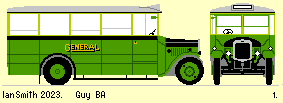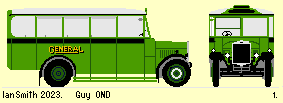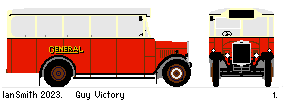The Pre-War Guy Single-deckersThis page created 4th April 2023.
Guy Single-deckersGuy Motors offered a series of small single-deckers in the late 1920s.PREMIER OMNIBUS COMPANY (Hewitt): Guy BA, BBThe Watford area saw several operators choosing small Guys for bus and coach operations. One was Ernest Hewitt, who started bus and coach operations in 1923 with a 14-seat Crossley, used for bus operations between Watford Market Place to Harebreaks when it was not needed for adverised excursions or private hire. A 20-seater Lancia bus followed in 1924, and in 1925 Hewitt bought the first of a succession of Guy BAs and BBs, with a variety of doorway positions (front, rear and dual), with either coach or bus seating. Bodywork was by Coulter of Woking, seating between 26 and 32 dependant on doorways. Livery was cream and maroon, with Premier fleetnames.Competition was fierce, especially by National: including some chasing. Lewis was another competitor (but not with Guys!). Co-operation between Hewitt (Premier), National and Lewis brought some co-ordination of fares and services in early 1926, perhaps in a bid to assuage the increasing wrath of Watford Council, the local licensing authority. The first Guy (RO771) was a dual entrance 26-seater BA, in May 1925. This was followed in February 1926 by another dual-doorway 26-seater (RO2290), on a BB chassis. The third Guy (RO3605), in May 1926, seated 32, by having only a rear doorway. The General Strike in 1926 somewhat soured relationships with Watford Council, which supported the strike. It persuaded Lewis to cease running. National, with a fully unionised workforce, ceased operation for the duration. The Council tried to persuade Hewitt to stop, but he refused unless compensated, which the Council would not do. Nevertheless Hewitt bought another two BBs in 1927 - a 32-seater coach with canvas roof (RO6842) and another 32-seater rear-entrance bus (RO7766). These replaced the elderly tiny Crossley, which still worked but was woefully undersized for current demand: it was sold to a Welsh operator. The Lancia was relegated to spare bus, and sold in April 1929. Hewitt wanted to operate an express service to London, but Watford Council were unco-operative, only allowing two inconvenient pickup points in the town. Hewitt acquired two more coaches, one of them a more powerful six-Cylinder Guy FC. These were good earners on the excusions to the coast and the races, but lost money on the London expresses, which were soon withdrawn. Hewitt then lost a lot of money with the Loumax/Royal Highlander debacle. Some of the surplus Guys bought for those concerns appeared on town services in Watford, where the state of the Premier bus fleet was deteriorating badly. Hewitt's Premier licence on the main bus route was reduced from six to three buses. Hewitt was in trouble. He wanted London General to buy his loss-making services, but Frank Pick turned down his approaches at first, then in 1933 accepted a lower offer to acquire the bus routes, but not the garage nor the vehicles. Hewitt then found it difficult to sell the buses, and found that the coach business was not doing so well either. None of his buses were bought by London Transport. Watford Co-operative, then Watford Omnibus: Guy BB, FBBThe Watford Co-operative and Mutual Omnibus & Transport Co Ltd had expansive plans in June 1926. They asked Watford Council to licence no fewer than eleven routes in the Watford area. The decision by National to sack participants in the General Strike provided a nucleus of available staff, but funds raised from shareholders only allowed the purchase of three new buses: two normal control Guy BBs and one forward control FBB. The Council granted six licences, much less than asked for but nevertheless more than the Co-op could fill with its own three buses. The Co-op borrowed buses from other concerns, including a pair of Guys from G.Warren & Son, who later in 1927 took them away to their new venture in Hampshire.
National: Guy BAs
General (the LGOC) bought six Guy BAs in 1928 on behalf of their North London subsidiary, National.
These were twenty-seaters with chunky Chiswick rear doorway bodywork on a 13ft 4in wheelbase chassis.
They operated Watford local services. They lasted the full seven years expected of the wooden buses of the period, lasting until May 1935,
having been reorganised into London General Country Services in April 1932 and London Transport (Country Area) in July 1933.
UC2267-2272 never received fleetnumbers, although they did receive London Transport green and black livery.
They were replaced by Leyland Cubs, the new standard small bus.
They operated from a garage in Pinner Road, Harrow. Routes became 140A (Pinner - Wealdstone) and later 351 (Hatch End to Harrow Met. Stn).
St.Albans: Guy BB/FBB/ONDThe St.Albans & District company of Charles Russett & Son was also a user of Guys: it bought a pair in 1927 and 1928, a 30-seater BB with a Vickers B30D body (DH 5901), and a forward control FBB with Waveney body (MP4406). These pottered around St.Albans, probably on the 304 to Hitchin and the 308 to Borehamwood.A more modern Guy, an OND with just 14 seats (JH 983), was operated in the St.Albans area by Karriyu Coaches (J.Kirby). All three were taken over by London Transport in November 1933, some four months after the Board's formation. London Transport had refused Russett's applications to work into the LT area. The two older Guys were quite promptly disposed of during 1934, but the small Karriyu bus survived with LT until 1936. East Surrey: Guy ONDIn 1928 East Surrey loaned some buses for trial purposes. One was a Duple-bodied Guy OND single-decker. It impressed, and was bought by East Surrey for their small-bus routes. It did a creditable six and a half years, grinding up and down narrow lanes on the Greensand ridge, lasting through London General Country Services into London Transport, until May 1935.Slough: Guy ONDThe Great Western Railway operated buses and coaches to and from Slough Station. In April 1932 the GWR services were taken over by Thames Valley and London General Country Services. The LGCS share included five Guys as well as some Maudslays. There were four Guy forward control FBBs, two buses with different B32R bodywork: YH1936 by Vickers, YH6819 by Hall Lewis, used for services linking Slough Industrial Estate with Slough Station and Windsor, and two coaches with Buckingham C32FR dual door bodies. These presumably worked to link Slough with places like Beconsfield. There was also a smaller bus, UV9120, a B18F Guy OND with Duple bodywork, which presumably competed with the horde of tiny buses between Slough and Windsor. The two coaches were numbered in the Greenline fleet as G1 and G2, and were sold by LT in 1934.
April 1931 saw the start of the 181A - with three of Hewitt's Guys.
Mrs Sayers had only been able to get three of the six licences that she wanted.
Hewitt used the other three on his Watford or West Herts routes,
where their condition was better than the Premier vehicles.
Mrs Sayers defaulted on the payments on the Beans, not pleasing Hewitt, who paid up.
She still managed to con a license-holder fee and an incoporation fee with debts cancelled,
whilst Hewitt actually ran the services.
Hewitt arranged to buy the Loumax business, but Mrs Sayers would not hand over the vehicles.
Instead she tried to sell the whole ensemble to the General, without telling Hewitt, who by now owned nearly all of it.
Mrs Sayers seized control of operations, and ran down maintenance of the vehicles, whilst taking all the fares.
When LGOC did take control in September 1932, the two Loumax Guys no longer had Certificates of Fitness so could not be used,
two of the Royal Highlander were docked for annual overhauls which were not progressing.
Just one was available for the 211 (out of three required),
two Guys were in use instead of Beans on the 206A and the 181A was not running at all!
It took some time for the LGOC to rectify their condition.
The Guy Victorys became G1-G6, and the Guy ONDFs G7-G8 in the LGOC and then London Transport fleets, operating from Harrow Weald. The original Loumax Guy had previously been sold to Rainham Bus Service.
Inevitably it went to court in March 1932, with an unsatisfactory conclusion to avoid all the assets going to the lawyers.
Hewitt had lost out heavily in this debacle. It affected his ability to manage his Premier and West Herts fleets in Watford.
|
 The Co-op's own BB buses were 26-seater rear entrance types, with the driver shut off in an open cab behind the long bonnet.
A tall destination display stood on the front of the roof. They wore a similar livery to Premier: cream with maroon.
They were too few to operate all the routes licensed by Watford,
but did work from Watford West via the High Street to Abbotts Langley, and from Harebreaks via the High Street to The Rookery, later to Oxhey Hall.
The Co-op did acquire or hire other buses, but never lived up to its promise.
In March 1931 it sold out to Benjamin Holt, whose garage it had been using.
Holt named his new operation Watford Omnibus, and took over the three Guys and other buses.
RO4573 probably never worked for the new company, being sold in May.
RO4574 and RO5301 worked for Watford Omnibus. Livery was now medium green with Watford fleetnames, and the buses had lower body-sides fitted.
These two survived to be taken over by London Country Bus Services in June 1933.
The Co-op's own BB buses were 26-seater rear entrance types, with the driver shut off in an open cab behind the long bonnet.
A tall destination display stood on the front of the roof. They wore a similar livery to Premier: cream with maroon.
They were too few to operate all the routes licensed by Watford,
but did work from Watford West via the High Street to Abbotts Langley, and from Harebreaks via the High Street to The Rookery, later to Oxhey Hall.
The Co-op did acquire or hire other buses, but never lived up to its promise.
In March 1931 it sold out to Benjamin Holt, whose garage it had been using.
Holt named his new operation Watford Omnibus, and took over the three Guys and other buses.
RO4573 probably never worked for the new company, being sold in May.
RO4574 and RO5301 worked for Watford Omnibus. Livery was now medium green with Watford fleetnames, and the buses had lower body-sides fitted.
These two survived to be taken over by London Country Bus Services in June 1933.
 Messrs Ashley and Westwood very early saw the potential for bus operation after the Great War,
starting services in developing Metroland around Wealdstone and Pinner.
Their early fleet of diminutive 12-seater Crossleys lasted from 1922-4 until 1926-9,
when they were replaced by three thirty-two seater rear-entrance Guys, one normal control Guy BB and two forward control Guy FBBs, one with old-fashioned opencab, and the other much more modern by Duple.
Messrs Ashley and Westwood very early saw the potential for bus operation after the Great War,
starting services in developing Metroland around Wealdstone and Pinner.
Their early fleet of diminutive 12-seater Crossleys lasted from 1922-4 until 1926-9,
when they were replaced by three thirty-two seater rear-entrance Guys, one normal control Guy BB and two forward control Guy FBBs, one with old-fashioned opencab, and the other much more modern by Duple.
 The company wanted out of Bus operation by the end of the twenties, and in June 1930 sold out to the General (LGOC).
LGOC promptly switched operation to their convenient Harrow Weald garage,
and replaced the three Guy buses after about six weeks in favour of standard LGOC S-types.
A&W retained their third Guy, a 32-seater forward entrance FC coach, for continued coach operation.
The company wanted out of Bus operation by the end of the twenties, and in June 1930 sold out to the General (LGOC).
LGOC promptly switched operation to their convenient Harrow Weald garage,
and replaced the three Guy buses after about six weeks in favour of standard LGOC S-types.
A&W retained their third Guy, a 32-seater forward entrance FC coach, for continued coach operation.
 Also originating with the GWR was another OND, UV9121, which had been sold earlier to Thames Valley
before being bought by the Nippy Bus Service for use on their routes between Windsor and Old Windsor,
and then between Windsor and Egham (Later Virginia Water). This little bus company, working into what became the London Transport area, was compulsorily purchased by London Transport in February 1934.
Also originating with the GWR was another OND, UV9121, which had been sold earlier to Thames Valley
before being bought by the Nippy Bus Service for use on their routes between Windsor and Old Windsor,
and then between Windsor and Egham (Later Virginia Water). This little bus company, working into what became the London Transport area, was compulsorily purchased by London Transport in February 1934.
 Mrs Sayers had expansionist aspirations, and bought a pair of forward control 20-seater Duple Guy ONDFs in March and April 1930.
She obtained permission to operate a 210B service between Greenford (Hare & Hounds) and Hanwell Station (Park Hotel),
with a 210 between North Harrow and Ealing Broadway on Sundays.
Route number 211 was originally North Harrow - Northolt on Sundays, later Pinner (Red Lion)-Northolt. This did not survive long, route 211 in March 1931 becoming Greenford (Hare & Hounds) to Ealing Broadway in place of 210B.
Being short of money, Mrs Sayers approached Ernest Hewitt, (he of Premier (Watford) renown).
She claimed to be able to get ten licences within the Metropolitan Police area,
four for Ealing-Greenford and six for Pinner-Uxbridge, under the Royal Highlander banner.
Mrs Sayers had expansionist aspirations, and bought a pair of forward control 20-seater Duple Guy ONDFs in March and April 1930.
She obtained permission to operate a 210B service between Greenford (Hare & Hounds) and Hanwell Station (Park Hotel),
with a 210 between North Harrow and Ealing Broadway on Sundays.
Route number 211 was originally North Harrow - Northolt on Sundays, later Pinner (Red Lion)-Northolt. This did not survive long, route 211 in March 1931 becoming Greenford (Hare & Hounds) to Ealing Broadway in place of 210B.
Being short of money, Mrs Sayers approached Ernest Hewitt, (he of Premier (Watford) renown).
She claimed to be able to get ten licences within the Metropolitan Police area,
four for Ealing-Greenford and six for Pinner-Uxbridge, under the Royal Highlander banner.
 Hewitt bought six Duple-bodied Guy OND Victory B20F buses on hire purchase for the Pinner Uxbridge route 181 over the period March-July 1931.
Mrs Sayers was to buy narrow-bodied Beans for the 211, the narrow bodies being required for the this route.
However her credit was insufficient for her to buy the Beans,
so Hewitt arranged their hire-purchase, with her to pay the instalments.
A third Bean arrive in December 1931 when Mrs Sayers sold her Loumax Guy.
Hewitt bought six Duple-bodied Guy OND Victory B20F buses on hire purchase for the Pinner Uxbridge route 181 over the period March-July 1931.
Mrs Sayers was to buy narrow-bodied Beans for the 211, the narrow bodies being required for the this route.
However her credit was insufficient for her to buy the Beans,
so Hewitt arranged their hire-purchase, with her to pay the instalments.
A third Bean arrive in December 1931 when Mrs Sayers sold her Loumax Guy.
 Bus Stop
Bus Stop Guy text.
Guy text. bus histories
bus histories